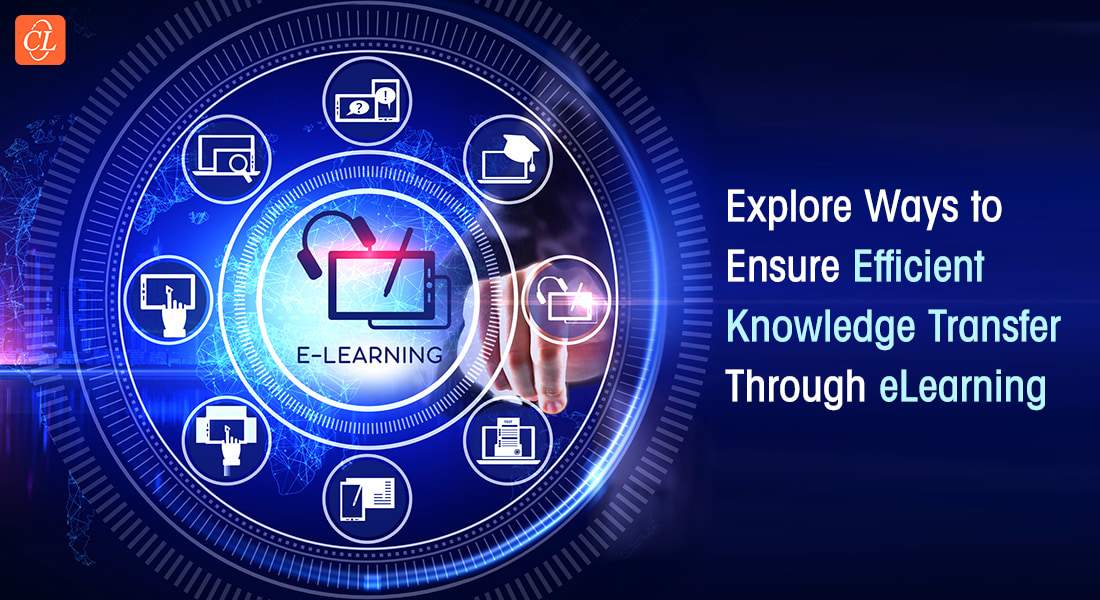Top 6 Ways to Ensure Knowledge Transfer Through eLearning
Explore the top 6 corporate L&D strategies for ensuring efficient knowledge transfer through eLearning.

When developing eLearning solutions, it is crucial to review each stage of the process, whether it is during course planning, design, development, or delivery. There are numerous positions in corporate L&D. Some oversee managing efficient training administration and delivery, while others are in charge of course creation and instructional design. However, the aim of all these various job functions is knowledge transfer.
However, the design and development of eLearning is a time-consuming process that involves several processes running at once. How can you then ensure that each procedure is contributing to a successful knowledge transfer?
In corporate L&D, we should not lose sight of the main objective of training, which is efficient knowledge transfer, in our pursuit of planning, producing, and delivering informative and engaging training solutions. Here is a list of 6 recommendations to help all learners efficiently transfer knowledge through eLearning.
你想知道如何保证知道吗ledge Transfer Through eLearning?
Here are the Top 6 Tips:
- Perform a Training Need Analysis (TNA)
- Match Training with Business Objectives
- Explain “What’s in it for them?” To Learners Clearly
- Prepare for Just-in-Time Training
- Integrate Present Training with Prior Knowledge or Experience
- Make the Content Organized to Boost Engagement and Retention
Top 6 Recommendations to Ensure Knowledge Transfer Through eLearning
1. Perform a Training Need Analysis (TNA)
The process by which a corporation determines the training and development needs of its personnel so that they can do their jobs successfully is known astraining needs analysis(TNA). It entails a thorough review of the training requirements needed at various organizational levels.
A TNA helps you:
- Determine the training and development needs that must be satisfied.
- Identify gaps of knowledge that need to be fulfilled.
- Create learning goals based on the needs identified.
2. Match Training with Business Objectives
Workplace learning serves many purposes than merely employee growth. It also has a direct impact on how well the organization does. For bothclassroom and online training programsto be successful, it is essential to match training requirements to the firm’s business goals.
By connecting your training to your company’s objectives:
- The knowledge imparted to learners will be applied in real-world situations.
- The ROI of your training will be higher.
- According to Brandon Hall Report, there is a 53% greater chance that business KPIs will rise
Find out how you, as an eLearning Champion, can increase training effectiveness!
3. Explain “What’s in it for them?” To Learners Clearly
An unambiguous statement that describes whatever the learner should be ready to execute after completing the course is called alearning objective.
- If adult learners understand how the training will benefit them in their careers, they will be more motivated to learn.
- 学习者还将理解的价值training through the “What’s in it for me”
4. Prepare for Just-in-Time Training
With the development of technology, every profession today has changed. Today’s workers must address problems quickly, and they anticipate having access to information at all times. Problems do not always make themselves known. You should thus have a strategy for always making knowledge available to learners.
Therefore, be sure to:
- Create responsive and flexible eLearning courses that can be accessed on a range of devices and at any time
- Build an online repository of different microlearning assets
5. Integrate Present Training with Prior Knowledge or Experience
Pre-tests are a useful tactic that can assist determine what knowledge learners already have before beginning an eLearning Course. This aids in creating courses that are suited for learners’ comprehension levels. The learners may be guided to a course more appropriate for their requirements, such as advanced level eLearning or expert-supported hands-on training depending on how well they did on the pre-test.
So, it is important to note that:
- When new material is based upon prior knowledge, learners comprehend and remember it better.
- At the start of the courses, you may test learners’ retention of prior instruction by using quizzes, icebreakers, brief scenarios, or video clips.
6. Make the Content Organized to Boost Engagement and Retention
One of the crucial components ofinstructional designfor efficient learning is determining the best approach to convey information in a simple and engaging way. The possibilities are endless when it comes to creatively present information. The learning goals and the desired result should be considered while using role plays, interactive videos, storytelling, branching scenarios, gamification, and other techniques.
So, be sure to:
- Only provide information that is necessary to know
- Steer clear of lengthy text blocks. Use visuals and drawings to break up text
- To make information easier to grasp, use visualizations, charts, infographics, etc.
Parting Thoughts
To guarantee efficient knowledge transfer, start by matching your company goals with your training goals. It is also the cornerstone of a successful instructional design strategy. You will find this free eBook on “Instructional Develop 101” to be informative and interesting if you want to learn more on how to design an efficient eLearning solution.






